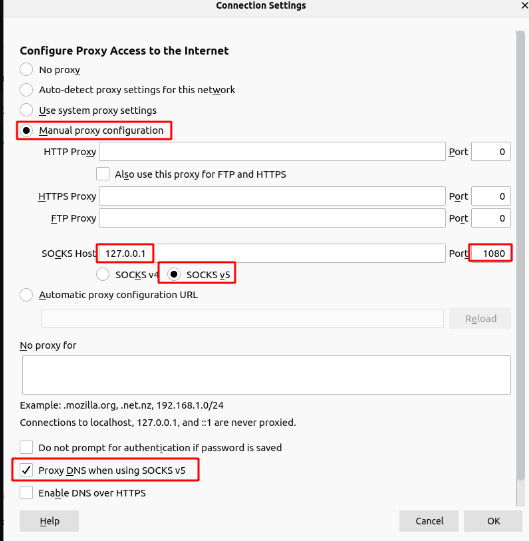|
Size: 1226
Comment:
|
Size: 2657
Comment:
|
| Deletions are marked like this. | Additions are marked like this. |
| Line 3: | Line 3: |
| To get Web access to I-MATH intranet webserver it's possible to setup a SOCKS SSH proxy channel: | To get Web access to I-MATH intranet webserver it's possible to setup a SOCKS SSH proxy channel. This is setting is not persistent, start it when you need it. The proxy configuration can be done: * on the OS - ''not described here''. * via commandline - described here for ''Google Chrome'' and ''Opera''. * inside the browser via GUI - described here for ''Firefox''. == Start SSH Proxy == |
| Line 10: | Line 18: |
| * Open SSH Socks connection: {{{ # On the local computer $ ssh -C -D <I-MATH account>@ssh.math.uzh.ch # Type in your I-MATH password and leave the connection open all time! |
* On your '''local computer''' open a terminal and start the SSH Socks connection (provide your I-MATH password and leave the connection open all time): {{{ ssh -C -D 1080 <I-MATH account>@ssh.math.uzh.ch |
| Line 19: | Line 22: |
| * Tell the browser to use the new proxy connection. | * This terminal won't be used anymore, but it has to be open as long as the proxy is in use! |
| Line 21: | Line 24: |
| * To use the I-MATH intenal DNS Server (necessary get access to hostnames that are only known inside of I-MATH), use the SOCKS5 protocol, incl. DNS forward. | == Start the Browser == To use the I-MATH internal DNS Server (necessary to get access to hostnames that are only known inside of I-MATH), use the SOCKS5 protocol '''incl. DNS forward'''. |
| Line 23: | Line 28: |
| * Google Chrome | For Google Chrome or Opera, open a second terminal and type the following command. |
| Line 25: | Line 30: |
| * `google-chrome --proxy-server="socks5://localhost:1080"` * Mac OS X: `/Applications/Google\ Chrome.app/Contents/MacOS/Google\ Chrome --proxy-server="socks5://localhost:1080" * Opera * `opera --proxy-server="socks5://localhost:1080"` * Mac OS X: `/Applications/Opera.app/Contents/MacOS/Opera --proxy-server="socks5://localhost:1080" |
|| Browser || Command || || Google Chrome || Linux: `google-chrome --proxy-server="socks5://localhost:1080"`<<BR>>Mac OS X: `/Applications/Google\ Chrome.app/Contents/MacOS/Google\ Chrome --proxy-server="socks5://localhost:1080"`|| || Opera || Linux: `opera --proxy-server="socks5://localhost:1080"`<<BR>>Mac OS X: `/Applications/Opera.app/Contents/MacOS/Opera --proxy-server="socks5://localhost:1080"`|| |
| Line 37: | Line 36: |
| * There is no officially option '-proxy-server' for the commandline * Start firefox, open 'settings', navigate to 'network': |
* There is no officially option '-proxy-server' for the commandline * Start firefox, open 'settings', navigate to 'network' > screenshot {{attachment:ff-proxy.png}} == FAQ == * Q: Can I configure Google Chrome / Opera via GUI like Firefox * A: yes - just check the 'network' seetings. * Q: Why should I start Google Chrome / Opera via commandline? * A: This is a very quick way to use the proxy. If you do not need it, start the browser via mouse. * Q: Can I automate the steps? * A: yes. A small bash script should do the trick: {{{ #! #!/bin/bash nohup google-chrome --proxy-server="socks5://localhost:1080" & ssh -C -D 1080 <I-MATH account>@ssh.math.uzh.ch }}} * Check [[ssh#Working_with_SSH_Keys|SSH Keys]] to setup password less SSH login. * Q: in Firefox I don't like to toggle the proxy on/off all the time - is there a better way? * A: Create an additional profile 'proxy'. Start Firefox via Terminal `firefox -P`, create the profile, use it and do the proxy config there. |
(Web) Proxy by SSH
To get Web access to I-MATH intranet webserver it's possible to setup a SOCKS SSH proxy channel. This is setting is not persistent, start it when you need it.
The proxy configuration can be done:
on the OS - not described here.
via commandline - described here for Google Chrome and Opera.
inside the browser via GUI - described here for Firefox.
Start SSH Proxy
- Use SSH
Linux & Mac OS X: preinstalled.
Windows: https://www.howtogeek.com/336775/how-to-enable-and-use-windows-10s-built-in-ssh-commands/
On your local computer open a terminal and start the SSH Socks connection (provide your I-MATH password and leave the connection open all time):
ssh -C -D 1080 <I-MATH account>@ssh.math.uzh.ch
- This terminal won't be used anymore, but it has to be open as long as the proxy is in use!
Start the Browser
To use the I-MATH internal DNS Server (necessary to get access to hostnames that are only known inside of I-MATH), use the SOCKS5 protocol incl. DNS forward.
For Google Chrome or Opera, open a second terminal and type the following command.
Browser |
Command |
Google Chrome |
Linux: google-chrome --proxy-server="socks5://localhost:1080" |
Opera |
Linux: opera --proxy-server="socks5://localhost:1080" |
- Firefox
- There is no officially option '-proxy-server' for the commandline
Start firefox, open 'settings', navigate to 'network' > screenshot

FAQ
- Q: Can I configure Google Chrome / Opera via GUI like Firefox
- A: yes - just check the 'network' seetings.
- Q: Why should I start Google Chrome / Opera via commandline?
- A: This is a very quick way to use the proxy. If you do not need it, start the browser via mouse.
- Q: Can I automate the steps?
A: yes. A small bash script should do the trick:
#!/bin/bash nohup google-chrome --proxy-server="socks5://localhost:1080" & ssh -C -D 1080 <I-MATH account>@ssh.math.uzh.ch
Check SSH Keys to setup password less SSH login.
- Q: in Firefox I don't like to toggle the proxy on/off all the time - is there a better way?
A: Create an additional profile 'proxy'. Start Firefox via Terminal firefox -P, create the profile, use it and do the proxy config there.
